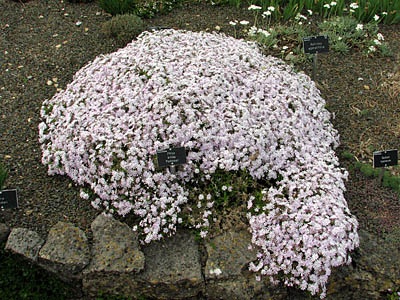Phlox
|
This is a group of hardy and tender plants, which are native of North America. The name Phlox means flame, in regard to the bright colors of the blooms. These plants are great for borders, rock gardens and flowerbeds. The annual kinds can be grown in a greenhouse for spring and winter bloom. They are also useful for cutting their flowers. P. drummondii is a bushy or trailing annual that is self-branching and grows 8 to 24 inches. The ovate to lanceolate leaves grow up to 3 inches long. Their flowers grow in bunches and up to an inch across. They come in rose, crimson, scarlet, pink, pale yellow, violet, or white. They usually have contrasting eyes. Varieties of P. paniculata and P. carolina grow tall and are perennials. The produce flowers in various hues ranging from white to blush to rose, crimson and scarlet and through lavender to purple. These Phloxes bloom in the summer from July to September. Dwarf, perennial Phloxes that bloom in the spring are great for the rock and wild gardens. P. adsurgens is one of the most beautiful. It's low growing and has wide leaves and large flowers, which are produced in loose clusters on 4- or 5-inch stems in May and June. The flowers are pink with a band of darker pink down the center of each petal. P. divaricata (also known as P. canadensis), the Wild Sweet William, grows in the woodlands of North America. It has wide leaves and erect growth. Its attractive, large flowers grow in loose heads on 6 to 9 inch stems in May and June. They are colored a gorgeous lavender-blue and have a light scent. There are many more kinds that will be mentioned below in the varieties section.
Pot CultivationThe annual Phlox may be planted in well-drained, sandy soil that is moist to on the dry side. They should be placed in a sunny position. They can also be cultivated in a sunny greenhouse. When their pots are full of healthy roots, applications of dilute liquid fertilizer may be given once a week. They should be staked and tied carefully before they are too tall and fall over. The perennial, summer flowering Phloxes will flourish in full sun or partial shade as long as the soil is moist throughout dry, hot weather. If the garden soil is poor and sandy, it is better to plant them in partial shade to prevent the soil from drying out. To give your plants the best care, plenty of decayed manure should be added to the lower layer of soil and the best times to plant is in early autumn or early spring. Phloxes are surface rooting, therefore they should be kept moist by mulching the soil around them with compost, peat moss or decayed manure. When growth begins again in the spring, slugs may injure the young shoots. Sprinkling sifted ashes around the bases of the plants usually discourages these pests. Nematodes can also damage Phlox. Sterilization of the soil will prevent these. When the leaves die in the fall, the stems should be pruned within about 2 inches of the ground. It is smart to set ashes or sand around the plants to help protect the roots. Summer flowering Phloxes should be given a complete fertilizer every spring just before they begin growing. Pinching the shoots when they're about 6 inches high will encourage bushy plants, but the flower clusters won't be as large. The spring flowering, dwarf Phloxes will flourish in light loam and leaf mold in a partially shaded placed in the rock garden. PropagationSeeds should be chilled in the refrigerator a week before planting. They may be started indoors at a 65-degree temperature, 8 to 10 weeks before it's safe to plant outside. They should be sown in two parts of loam and one part of leaf mold or peat moss, with a liberal amount of sand added. Lightly cover them. Set a pane of glass over them. Gradually harden them off before setting outdoors. When they are to grow in a sunny greenhouse, seeds may be sown in pots of sandy soil from August to February to provide blooms in the late winter and early spring. The perennial, summer flowering Phloxes can be increased readily by cuttings, which may be taken at any time during the spring and summer. Fresh shoots of the current year's growth are used; those that are flowerless are the best choice, though even the tops of shoots that have flowered may be used if necessary. Insert these into a bed of sand in a frame and keep it closed and shaded for a few weeks. They may also be set in sandy soil in a shady place and covered with a bell jar. Do not over water them or else they will damp off. Water them as soon as they are planted; afterwards, just sprits them with water. This kind of Phlox can also be propagated by root cuttings taken in early autumn. The easiest way to increase perennial Phloxes is by separating large clumps into several rooted pieces in October or early spring and replanting immediately. Only the outer pieces should be used to replant because these are the younger portions. However, the best method is to raise new plants from cuttings. The perennial, spring flowering Phloxes may be increased by seeds sown in the spring, by soft cuttings of non-flowering shoots taken in early summer and inserted in a bed of sand in a cold frame, or by root division in the spring or early summer.
Varieties
|






